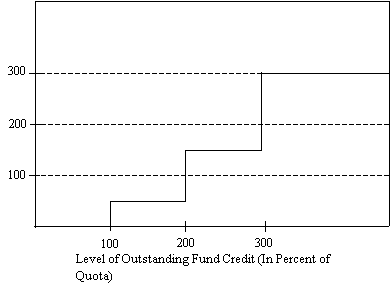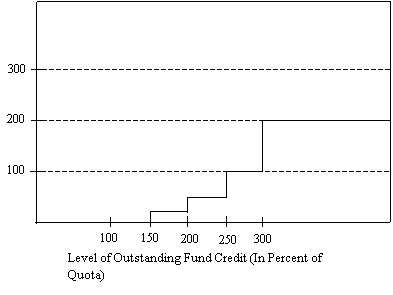|
Public Information Notice: IMF Board Agrees on Changes to Fund Financial Facilities Review of Fund Facilities—Follow Up
Concluding Remarks by the Chairman of the IMF Executive Board Review of Fund Facilities — Further Considerations
Review of Fund Facilities — Further Considerations Supplementary Information on Rates of Charge Review of Fund Facilities—Further Considerations Review of Fund Facilities -- Preliminary Considerations |
|
|
|
Review of Fund Facilities — Follow Up 1. The Executive Board had a useful exchange of views on the review of Fund facilities on September 7, 2000, and this was followed by additional discussion in the International Monetary and Financial Committee preparatory meeting of Deputies in London on September 11. This short supplement lays out elements of a possible package of changes, providing further information in a few areas. 2. There appears to be an emerging consensus that the problem of long use of Fund resources following the resolution of a balance of payments problem should be addressed through the introduction of time-based repurchase expectations. According to the proposal in the main staff paper (Box 3), in stand-by arrangements (SBAs), members would be expected to begin repurchases after 2¼ years, as compared with the timing of the first repurchase obligations at 3¼ years. Under the Extended Fund Facility (EFF), members would begin repurchases after 4½; years, as at present, but the amounts of each repurchase expectation would be double the amounts of the obligations, so that the expected repurchases would be completed in 7 years, rather than 10 years under the obligation schedule. The member would be expected to meet these expectations, but the Fund could extend them on request by the member, if the Board agreed that the member’s external position had not improved sufficiently for repurchases to be made. The member could make such a request at any time when expected repurchases remained to be made, and the Board could either agree to the request by extending any or all remaining expected repurchases or deny the request. Fund-supported programs would normally continue to be formulated on the assumption that the member would meet the repurchase obligations (rather than the expectations), and the member’s ability to meet expectations would be intended to signal a stronger-than-expected improvement in its external position, rather than a failure to achieve the targeted improvement. The construct would need to be explained carefully to the public, and in this context, following suggestions by Executive Directors, it is proposed that the word “waiver” be avoided, and that reference be made instead to “extensions” of repurchase expectations. |
|
3. In the case of SBAs, the period before repurchase expectations begin could be shortened further, but there are arguments against this. The evidence presented in the staff paper “Review of Fund Facilities—Further Considerations” (EBS/00/131, July 10, 2000) that actual balance of payments needs are often significantly shorter than projected needs (and indeed are in many cases of less than one year’s duration) would appear to support a further shortening. However, there are some reasons why a more modest shortening for SBAs might be preferable:
4. Time-based repurchase expectations would not apply to credit outstanding at the time the policy change was introduced, but would apply to all purchases made after the policy change, including those under arrangements in existence at the time of that change. It is not legally possible to differentiate between purchases made under arrangements in existence at the time of the policy change, and arrangements granted thereafter, and to introduce repurchase expectations only into the latter. This is because the same policies must apply to all purchases made at the same time under the same facilities by different members (whether these members have preexisting or new arrangements). 5. Could Directors accept a solution to the problem of long use following the resolution of a member’s balance of payments problem that would consist of time-based repurchase expectations, within a timeframe of 2¼ - 4 years under a SBA and 4½ - 7 years under the EFF? 6. As a supplement to repurchase expectations, the Board has discussed the introduction of surcharges on credit outstanding above a certain level under the credit tranches and the EFF. The surcharge might begin at a level between 100 percent of quota and 300 percent of quota. The former level is comparable to the member’s entitlement under Article V, Section 3 (b)(iii);2 the latter is equivalent to the current cumulative limit on access under the credit tranches and the EFF. Intermediate levels could also be chosen, and if a relatively low initial level was chosen the surcharge could be graduated at higher levels of credit outstanding. Figure 1 (reproduced for ease of reference from the main paper) and Figure 2 present a number of possible options in this regard—including different thresholds for the surcharge (100-300 percent of quota), initial rates of surcharge (ranging from 25 basis points to 300 basis points in the option involving the highest threshold), maximum rates of surcharge (200-300 basis points), and numbers of steps (1-4) to reach the maximum surcharge. 7. Key features of level-based surcharges would include the following:
|
|
| Figure 2. Level-Based Surchages: Options L4-L6 | ||
|---|---|---|
| Option L4 | ||
 |
The surcharge starts at 100 percent of quota with an initial rate of 50 basis points. It increases by 100 basis points at 200 percent of quota, and by 150 basis points at 300 percent of quota, to reach a maximum rate of 300 basis points. |
|
| Option L5 | ||
 |
The surcharge starts at 150 percent of quota with an initial rate of 50 basis points. It increases by 50 basis points at 200 percent of quota, by 75 basis points at 250 percent of quota, and by 125 basis points at 300 percent of quota to reach a maximum of 300 basis points. |
|
| Option L6 | ||
 |
The surcharge starts at 150 percent of quota with an initial rate of 25 basis points. It increases by a further 25 basis points at 200 percent of quota, by 50 basis points at 250 percent of quota, and by 100 basis points at 300 percent of quota to reach a maximum of 200 basis points. |
8. Graduated charges would not apply to credit outstanding at the time the policy changes were introduced, but there would be various options for the transitional treatment of purchases made after the introduction of the policy changes. A surcharge related to the level of credit outstanding would apply only to new purchases, and as with time-based repurchase expectations it would have to apply equally to purchases under both preexisting and new arrangements. As regards the treatment of new purchases, there are essentially two options:
9. Could Directors accept graduation with the level of credit outstanding? What parameters (from among those presented in Figures 1-2, or others) would be acceptable? By way of transitional arrangements, it is clear that existing credit outstanding would not be subject to surcharges, but would Directors wish to ignore or take into account existing credit in the determination of the surcharge payable on new purchases? 10. As regards the Contingent Credit Lines (CCL), there appears to be broad agreement in several areas, although some issues in the area of monitoring and exit remain a subject for discussion. Table 1 summarizes the current structure of the CCL, and changes proposed by the staff. 11. There is broad agreement that the following changes should be made to the CCL:
|

12. An issue that remains the subject of debate is monitoring arrangements under the CCL. It is agreed that the Fund must have the means to make a member exit from the CCL—that is, to interrupt the member’s (conditional) right to make any purchases associated with the activation review. These means take the form of the limited (one-year) commitment period under the current CCL and, importantly, the midterm review. At the same time, however, some Directors are concerned that monitoring under the CCL may be unduly intrusive, in a manner that is not reflective of the situation of a country that has successfully prequalified for the CCL. These Directors point, in particular, to the requirement in the CCL decision that the member submit to the Fund, as part of its request for a commitment of CCL resources, “a satisfactory economic and financial program, including a quantified framework” —which could be interpreted to mean a program specified in the same way as it would be for a stand-by or extended arrangement.4 13. Several options could be considered to make monitoring under the CCL less intrusive:
14. Could Directors accept the changes to the CCL summarized in Table 1? 15. There appears to be fairly wide agreement that enhanced post-program monitoring (PPM), with more formal involvement of the Board, can be useful in certain cases. It may be possible to establish a presumption that members that meet certain criteria would engage in post-program monitoring by the Fund of their circumstances and policies after the expiration of their arrangements. The implementation of such a presumption could take place along the following lines:
In other respects (e.g., focus of discussions and content of reports, frequency of Board discussion, and possible recourse to consideration on a lapse-of-time basis) provisions for PPM would be as proposed in the main paper. Experience with PPM could be reviewed in about 18 months. 16. Could Directors accept procedures for post-program monitoring along the lines set out in the previous paragraph? |
| Features | Current | Proposed |
|---|---|---|
| 1. Eligibility requirements | See Decision | Unchanged |
| 2. Surcharge | Starting at 300 basis points, rising over time to 500 basis points | Starting at 150 basis points, rising over time to 350 basis points |
| 3. Commitment fee on approval of the commitment of CCL resources | 25 basis points on the total amount committed (expected to be in the range 300-500 percent of quota) | 25 basis points only on the amount scheduled (normally 5-25 percent of quota) |
| 4. Activation review | - Combines release of purchase on activation and phasing of remaining resources - Purchase on activation not specified at the time of approval of the commitment of CCL resources - Fund verifies member’s willingness to adjust policies as needed |
- Divided into “activation” and “post-activation”
reviews - Purchase on activation (large) specified at the time of approval of the commitment of CCL resources - In the activation review, Fund gives the member the strong benefit of the doubt as to its willingness to adjust policies as needed - Post-activation review sets phasing and includes understandings on policy adjustments |
| 5. Midterm review 1/ | Discussed by the Board | Could be completed on a lapse of time basis |
| 6. Specification of initial program 1/ | Similar to specification in other arrangements: - Quantitative benchmarks, on a quarterly or monthly basis, similar in coverage to performance criteria - TMU - Structural benchmarks |
Less elaborate than specification in other arrangements: - Policy framework reflected in a quartely baseline scenario for monitoring purposes - No TMU - No structural benchmarks |
1/ “Current features” correspond to the implicit or explicit expectation in the existing decision and summing up. “Proposed features” correspond to the normal treatment expected following reconsideration. |
The proposal in the main paper could result in this happening in the case of SBAs lasting for more than two years, but most such SBAs are expected to turn precautionary before the first repurchase expectation would fall due at 23 years. |